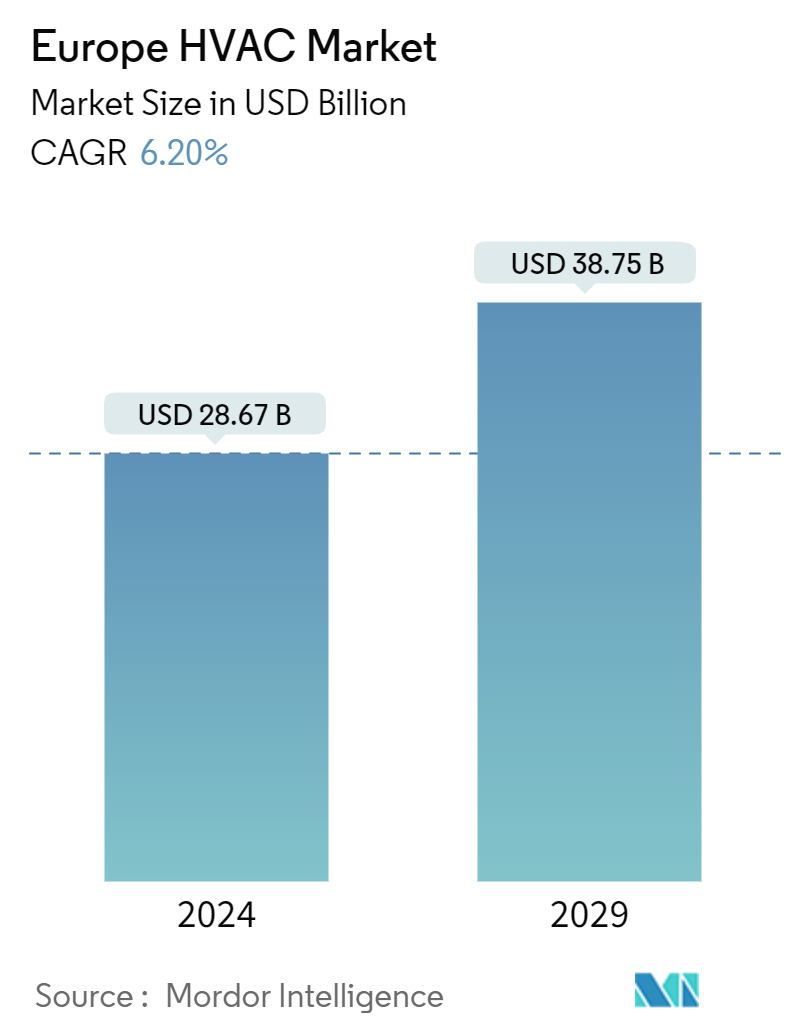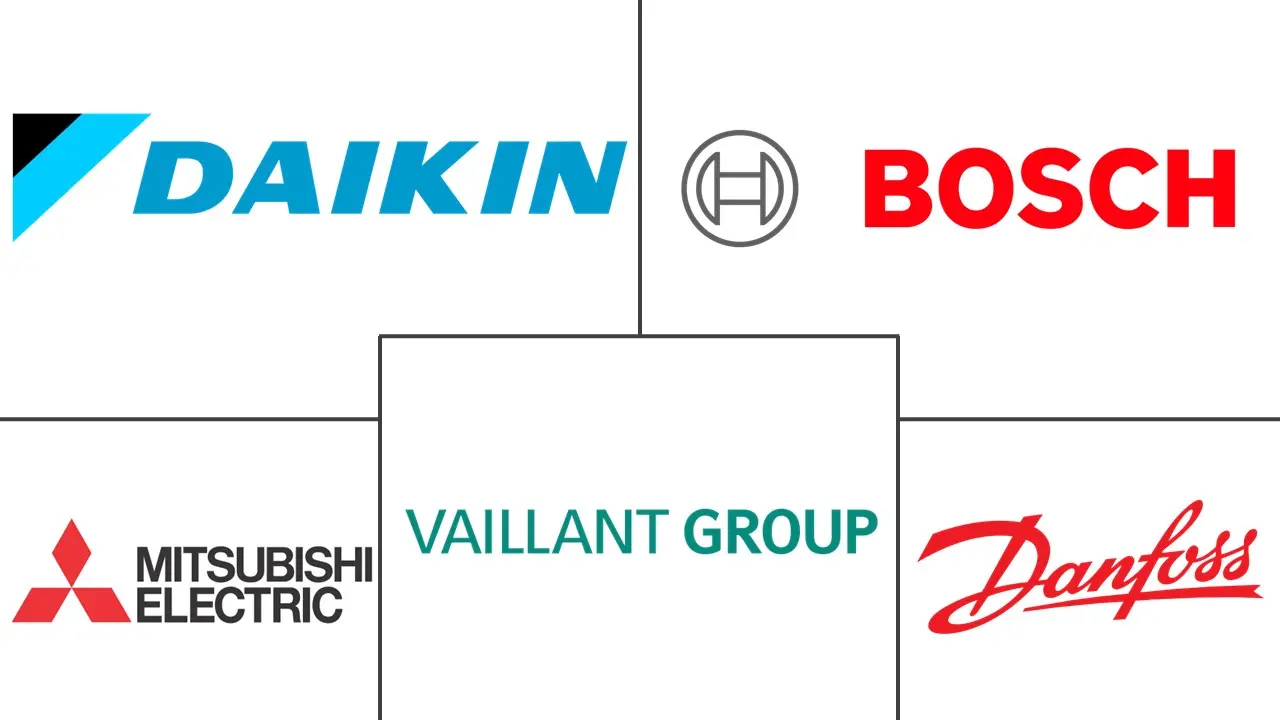Market Size of Europe HVAC Industry

| Study Period | 2019 - 2030 |
| Base Year For Estimation | 2023 |
| Market Size (2024) | USD 28.67 Billion |
| Market Size (2030) | USD 38.75 Billion |
| CAGR (2024 - 2029) | 6.20 % |
| Market Concentration | Low |
Major Players
*Disclaimer: Major Players sorted in no particular order |
Europe HVAC Market Analysis
The Europe HVAC Market size is estimated at USD 28.67 billion in 2024, and is expected to reach USD 38.75 billion by 2030, growing at a CAGR of 6.20% during the forecast period (2024-2030).
- Many buildings worldwide, including schools, offices, homes, and factories, still rely on fossil fuels, particularly natural gas, for heating, leading to large amounts of greenhouse gas emissions. Moreover, the current global energy crisis implies that there is an urgent need to move to more affordable, reliable, and cleaner ways of heating buildings. In this context, heat pumps, which can efficiently provide heating to buildings and industries, are one the key technologies to make heating more secure and sustainable.
- According to the IEA, heat pumps have the ability to minimize global CO2 emissions by a minimum of 500 million ton by 2030, equating to the yearly CO2 emissions of all cars in Europe.
- As a result, governments are looking forward to introducing stringent regulations, including mandating the incorporation of heat pumps. This is expected to positively impact the market studied. The European Union also announced the installation of 60 million more heat pumps by 2030, which is in line with the EU targets. This could cut the European Union's gas demand for buildings by 40% by 2030 compared to the 2022 levels and decrease its energy import bill by EUR 60 billion (USD 64.28 billion).
- In March 2023, the European Commission announced key changes to state aid guidelines, which should boost the heat pump sector. The EU wants more relaxed rules on subsidies for specific European sectors to avoid losing out to the Inflation Reduction Act, the US's green technology plan. The sectors include heat pumps and others like wind turbine and battery manufacturing. The European Union has planned to install 10 million heat pumps between 2023 and 2027.
- The industry is heavily controlled by distributors and component suppliers operating in different regions. The raw materials required to manufacture HVAC equipment are electronics, plastics, and compressors. Honeywell is a company that provides AC compressors. The dependence on suppliers for enhanced HVAC systems increases their bargaining power and the production cost of the product. Therefore, the switching cost of these suppliers to other companies is also high. This adds up to the competition in the market, challenging the market's growth.
- The importance of a proper ventilation system was highlighted by the COVID-19 pandemic, and several regional governments have promoted HVAC systems to reduce the spread of the virus. This has boosted the market.
Europe HVAC Industry Segmentation
The market is defined by the revenue generated from the sale of heating, ventilation, and air conditioning equipment offered by different market players for a diverse range of end users. The market trends are evaluated by analyzing the investments made in product innovation, diversification, and expansion. Further, the advancements in the construction industry across the residential, industrial, and commercial sectors drive market growth in the studied market.
The European HVAC equipment market is segmented by equipment (air conditioning/ventilation equipment [single split/multi-splits, variable refrigerant flow (VRF), air handling units, chillers, fans coils, packaged and rooftops, and other air conditioning/ventilation equipment], heating equipment [boilers/radiators/furnace and heat pumps]), by end-user industry (residential, commercial, and industrial), and by country (United Kingdom, Germany, France, Italy, Spain, Russia, Nordic Countries, Rest of Europe). The report offers the market sizes and forecasts in terms of value (USD) for all the above segments.
| By Equipment | |||||||||
| |||||||||
|
| By End User Industry | |
| Residential | |
| Commercial | |
| Industrial |
| By Country*** | |
| United Kingdom | |
| Germany | |
| France | |
| Italy | |
| Spain | |
| Russia | |
| Denmark | |
| Finland | |
| Iceland | |
| Norway | |
| Sweden |
Europe HVAC Market Size Summary
The European HVAC market is poised for significant growth, driven by the urgent need to transition from fossil fuel-based heating systems to more sustainable alternatives like heat pumps. This shift is largely influenced by the increasing emphasis on reducing greenhouse gas emissions and the European Union's ambitious targets to enhance energy efficiency and reduce dependency on gas imports. The market is characterized by a high level of fragmentation, with major players such as Daikin Industries, Robert Bosch, and Mitsubishi Electric actively expanding their product offerings and strategic partnerships to capture a larger market share. The commercial segment, in particular, is expected to see robust growth as businesses seek to adopt energy-efficient solutions that align with sustainability goals and government regulations.
The demand for HVAC systems, especially heat pumps, is further bolstered by government initiatives and incentives across Europe, aimed at promoting the adoption of these technologies in both residential and commercial sectors. Countries like France are leading the charge with plans to replace traditional heating systems with heat pumps, supported by substantial government investment and incentives. The ongoing rise in residential construction and the increasing need for efficient cooling solutions due to rising temperatures also contribute to the market's expansion. As companies continue to innovate and invest in advanced HVAC technologies, the European market is set to experience substantial growth, positioning itself as a key player in the global transition towards sustainable energy solutions.
Europe HVAC Market Size - Table of Contents
-
1. MARKET INSIGHTS
-
1.1 Market Overview
-
1.2 Industry Attractiveness - Porter's Five Forces Analysis
-
1.2.1 Bargaining Power of Suppliers
-
1.2.2 Bargaining Power of Buyers
-
1.2.3 Threat of New Entrants
-
1.2.4 Threat of Substitute Products
-
1.2.5 Intensity of Competitive Rivalry
-
-
1.3 Industry Value Chain Analysis
-
-
2. MARKET SEGMENTATION
-
2.1 By Equipment
-
2.1.1 By Air Conditioning/Ventilation Equipment
-
2.1.1.1 Single Split/Multi-Splits
-
2.1.1.2 Variable Refrigerant Flow (VRF)
-
2.1.1.3 Air Handling Units
-
2.1.1.4 Chillers
-
2.1.1.5 Fans Coils
-
2.1.1.6 Packaged and Rooftops
-
2.1.1.7 Other Air Conditioning/Ventilation Equipment
-
-
2.1.2 By Heating Equipment
-
2.1.2.1 Boilers/Radiators/Furnace
-
2.1.2.2 Heat Pumps
-
-
-
2.2 By End User Industry
-
2.2.1 Residential
-
2.2.2 Commercial
-
2.2.3 Industrial
-
-
2.3 By Country***
-
2.3.1 United Kingdom
-
2.3.2 Germany
-
2.3.3 France
-
2.3.4 Italy
-
2.3.5 Spain
-
2.3.6 Russia
-
2.3.7 Denmark
-
2.3.8 Finland
-
2.3.9 Iceland
-
2.3.10 Norway
-
2.3.11 Sweden
-
-
Europe HVAC Market Size FAQs
How big is the Europe HVAC Market?
The Europe HVAC Market size is expected to reach USD 28.67 billion in 2024 and grow at a CAGR of 6.20% to reach USD 38.75 billion by 2030.
What is the current Europe HVAC Market size?
In 2024, the Europe HVAC Market size is expected to reach USD 28.67 billion.

